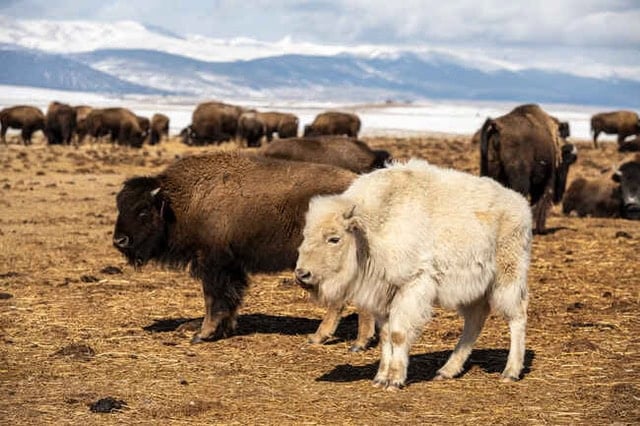Legend Of The White Buffalo Calf Woman

The myth of the white buffalo is a deeply revered legend among many Native American tribes, particularly the Lakota, Dakota, and Nakota Sioux. The most well-known and widely regarded version is the story of the White Buffalo Calf Woman. This myth is considered the most spiritually significant by many Native Americans.
The legend of the White Buffalo Calf Woman has been passed down through generations via oral tradition and is also referenced in various literature sources on Native American spirituality. Prominent spiritual leaders like Chief Arvol Looking Horse have spoken extensively about the significance of this legend and the importance of the white buffalo in contemporary times.
On June 4, 2024, a white buffalo calf was born in Yellowstone National Park, heralding a special omen for Native American and Indigenous peoples of North America. To honor this rare event, Farmers’ Almanac named June’s full Moon, which occurs on June 21, 2024 at 9:08 p.m. EDT, the “White Buffalo Moon.”
The Legend of White Buffalo Calf Woman
In the Lakota tradition, a time of hardship struck the people. Their chief, desperate to find food, sent two scouts on a vital mission. On their journey, they spotted a mysterious figure in the distance. It turned out to be a beautiful woman, but something about her felt otherworldly. One scout, blinded by desire, ignored his cautious companion and approached her. A swift punishment followed, and the man vanished.
Shaken but wiser, the other scout cautiously approached the woman. To his surprise, she revealed herself as a sacred being, known as a “wakan.” She entrusted him with a message—to return to his people and announce her arrival.
When the White Buffalo Calf Woman appeared, she wasn’t alone. She brought with her the most sacred object imaginable—the White Buffalo Calf pipe, a “chanupa.” This wasn’t just any gift. It came with knowledge. She taught the people seven sacred ways to pray, a foundation for their spiritual connection. These ceremonies include:
- The Sweat Lodge: A purification ritual for cleansing body and spirit.
- The Naming Ceremony: A celebration to welcome a child and bestow their new identity.
- The Healing Ceremony: A practice to restore health and balance to the physical, mental, and spiritual aspects of a person.
- The Adoption Ceremony: A formalization of kinship, creating a new family bond.
- The Marriage Ceremony: A sacred union that joins individuals together.
- The Vision Quest: A solitary journey to seek guidance, answers, and a deeper connection with the Creator.
- The Sundance Ceremony: A powerful prayer for the collective well-being of the Lakota people.
But the White Buffalo Calf Woman’s arrival wasn’t just about teachings. She promised a return—a time when harmony and spirituality would be restored to a world that had lost its way. With a final act of wonder, she rolled on the ground four times, each time changing color. In a dazzling transformation, she became a white buffalo calf and disappeared.
As she left, the Lakota people were surrounded by a gift—vast herds of buffalo. The birth of a white buffalo calf ever since has been a powerful sign, a confirmation that their prayers are heard and the promises of the White Buffalo Calf Woman hold true.
Any symbolic connections with christianity?
While the white buffalo is primarily rooted in Native American spirituality, some people draw connections between the sighting of a white buffalo and various elements of other religious traditions, including Christianity. In Christianity, white is often associated with purity, holiness, and the presence of God. The birth of a white buffalo, seen as a miraculous and pure event, can resonate with Christian themes of divine intervention and purity. Some people draw parallels between the birth of a white buffalo and the birth of Jesus Christ (as reported by the Associated Press), both seen as miraculous events heralding a new era of spiritual significance, hope, and fulfillment of prophecy.
The White Buffalo Calf Woman brought sacred teachings and rituals to the Lakota people, much like how Jesus provided teachings and a new covenant in Christianity. The emphasis on living in harmony, peace, and caring for the earth in the teachings of the White Buffalo Calf Woman can be compared to Jesus’ teachings about love, compassion, and stewardship of God’s creation.
How about other religions and belief systems?
- In Hinduism, white animals like the white elephant are considered sacred and lucky, often associated with gods and divine occurrences.
- In Buddhism, the white elephant is linked to the birth of Siddhartha Gautama, who later became the Buddha, signifying purity and spiritual enlightenment.
- The appearance of a white buffalo can be seen as a universal symbol of unity and a call for interfaith understanding and respect. Many people interpret such rare events as signs of a need for greater spiritual harmony and cooperation among different religious traditions.
- Some interfaith movements use symbols like the white buffalo to promote peace, understanding, and shared spiritual values across different cultures and religions.
Is a white buffalo an albino buffalo?
No, white buffalo can result from a variety of genetic mutations that affect pigmentation, but they are not albino. Their white coloration can be due to leucism, a condition characterized by reduced pigmentation in all skin and hair, but not in the eyes. White buffalo typically havare buffalo and busine normal-colored eyes, hooves, and skin. They may have dark eyes, black noses, and dark hooves. The fur is white or cream-colored, but other aspects of their physical appearance remain typical of buffalo. White buffalo are rare and occur naturally.
On the other hand, albinism is a genetic condition caused by the absence of melanin, the pigment that gives color to skin, hair, and eyes. It results from mutations in genes involved in melanin production. Albino buffalo exhibit a complete lack of pigmentation, resulting in white hair, pale skin, and pink or light blue eyes. Their eyes appear pink due to the visibility of blood vessels in the absence of pigment.
Buffalo or bison? Which is the correct term?
The calf born on June 4, 2024 in Yellowstone is a white American bison, not a buffalo. However the term “buffalo” is commonly used among Native American and indigenous peoples to refer to the American bison. This usage has historical and cultural roots, and despite the scientific distinction between bison and buffalo, “buffalo” remains widely accepted and understood in these communities.
Early European settlers in North America called the animals they encountered “buffalo” because they resembled the buffalo species (African and Asian) that they were familiar with. This term has persisted over centuries. The name “buffalo” was adopted into the vernacular of many Native American tribes through interactions with European settlers and has since been integrated into cultural traditions and language. Learn more about the difference between buffalo and bison.
The American bison, or “buffalo,” holds profound spiritual and cultural significance for many Native American tribes, regardless of its color. It is a symbol of abundance, strength, and survival, and it plays a central role in various ceremonies and stories.
Tribes such as the Lakota, Dakota, and Nakota often use the term “buffalo” in their languages and cultural references. For example, in the Lakota language, the word for buffalo is “tatanka.”
Today, the term “buffalo” is still commonly used by many Native American tribes, conservation organizations, and in popular culture to refer to the American bison. It is a part of the cultural identity and heritage of the tribes that traditionally relied on the buffalo for food, clothing, and tools.
While scientists and wildlife professionals use “bison” to maintain taxonomic accuracy, “buffalo” remains prevalent in everyday language and cultural contexts.
Any questions? Contact [email protected]
This article was published by the Staff at FarmersAlmanac.com. Any questions? Contact us at [email protected].







Very interesting article. It’s the first time I have read it. I had heard of the “White Buffalo Woman” but had never learned as much as I did today.
Thanks for sharing this story.
There was also a White Buffalo Calf born this spring in the heard that is kept by Fort Hays State University in Hays, Kansas, near historical Fort Hays. Information about it can be found on the Hays Post website.
Hi Michael! We are glad to hear that you enjoyed the article. Thank you for sharing what you know as well!
How many white buffalo or bison have been born since the legand began and when was the last one born?
Hi Brandi, Naturally born white buffalo and bison are rare. However, according to the US National Bison Association, there are no definitive records. Read more about it here – https://bisoncentral.com/the-white-bison-of-today/